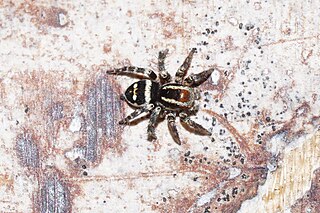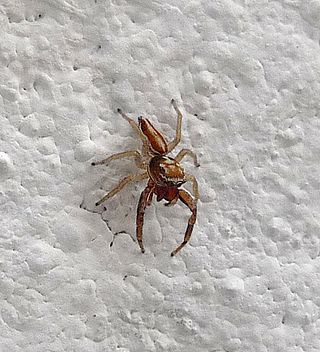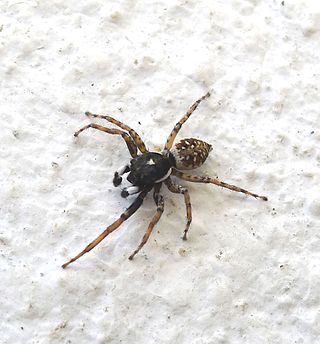Baryphas is a genus of jumping spiders that was first described by Eugène Louis Simon in 1902.

Heliophanus is a genus of the spider family Salticidae. Most of the almost 170 described species occur in Africa, with many others found in the Palearctic region from Europe to Japan.

Wanda Wesołowska is a Polish zoologist known for her work with jumping spiders. She has described more species of jumping spider than any contemporary writer, and is second only to Eugène Simon in the history of arachnology. Originally a student of ornithology, she developed an interest in jumping spiders while still a student at the Siedlce University of Natural Sciences and Humanities in the 1970s.

Mexcala torquata is a species of jumping spider in the genus Mexcala that lives in Guinea and Ivory Coast. It was first defined in 2009 by Wanda Wesołowska, one of over 500 that the arachnologist described during her career. The spider is medium-sized, with a dark brown carapace that is between 3.0 and 3.3 mm long and a brown abdomen between 3.0 and 3.7 mm long. It has long thin legs and serrated chelicerae. Similar to other species in the genus, it mimics ants and ant-like wasps, living alongside and preying upon them. The female has a distinctive fillet on the back of its abdomen, after which the species is named. However, it can be most easily distinguished from other spiders in the genus by its relatively small copulatory organs, specifically its very small epigyne, seminal ducts and embolus.
Thiratoscirtus gambari is a species of jumping spider in the genus Thiratoscirtus that lives in the forests of Nigeria. The species was first described in 2011 by Wanda Wesołowska and Russell-Smith. Female examples included at the time were later discovered to have been misidentified and so only a description of the male is available. It is a medium-sized spider, with a wider cephalothorax that is typically between 3.4 and 4.7 mm long and an abdomen that is 3.2 and 4.5 mm in length, both oval in shape. It is generally dark brown and grey on top and brownish-orange underneath, although some examples have a lighter underside to their abdomen, and has yellow to brown legs with brown hairs and spines. Its fang is unusual in having small angular features near its base. The spider also has distinctive copulatory organs that enable it to be distinguished from other members of the genus, particularly the relatively wide club-like tibial apophysis, or protrusion on its palpal tibia, and the wing-like appendages on its cymbium.

Phintella paludosa is a species of jumping spider in the genus Phintella that lives in Africa. It was first described in 2012 by Wanda Wesołowska and G. B. Edwards, from a holotype discovered in Cross River State, Nigeria, and was subsequently also found in Ivory Coast. The species was first seen in a swamp, so the species name is derived from the Latin for marshy. The spider is small, with a brown carapace and almost black abdomen. The female is smaller than the male. It is similar to the related Phintella aequipes but can be distinguished by the thick short embolus in the male of the species and the very small epigyne with copulatory openings at the rear in the female.
Vicirionessa signata is a species of jumping spider in the genus Vicirionessa from Africa. The species, first known as Brancus signata, was first described in 2016 by Angelika Dawidowicz and Wanda Wesołowska. The spider is small and yellow with a chevron pattern on its abdomen and teardrop shapes on its carapace, after which it is named. The first example was found in Kenya, but the range was extended to include Ivory Coast in 2022.
Vicirionessa fuscimana is a jumping spider species that lives in Sierra Leone, Ivory Coast, Nigeria, Cameroon, Equatorial Guinea and was first described by Eugène Simon in 1903 as Viciria fuscimana.
Neaetha maxima is a species of jumping spider in the genus Neaetha that lives in Ivory Coast and Nigeria. It was first described in 2011 by Wanda Wesołowska & Anthony Russell-Smith based on a holotype found near Ibadan. Only the female has been described. The spider is atypically large, over 10 mm (0.39 in) long, which is reflected in the species name. The genus name can be translated new aspect. It has a light brown carapace and yellow-white abdomen, with orange-brown legs. The epigyne has a distinctive central pocket and wide copulatory ducts.
Rhene timidus is a species of jumping spider in the genus Rhene that lives in South Africa. Only the female has been described, in 2013. The spider is typical of the genus, but larger than Rhene facilis, with a relatively large abdomen measuring 3.5 mm (0.14 in) in length. It has a distinctive epigyne featuring spiralling ridges.

Stenaelurillus glaber is a species of jumping spider in the genus Stenaelurillus that lives in Ghana, Ivory Coast, Nigeria and Uganda. It was first described in 2011 by Wanda Wesołowska and Anthony Russell-Smith. Only the male has been identified. The spider is small, with a brown cephalothorax 2.58 mm (0.102 in) in length and black abdomen between 2.05 and 2.4 mm long. The carapace is marked with four stripes and the abdomen by three white spots. It is distinguished from other members of the genus by its clypeus, which is entirely yellow and hairy.

Detalik is a genus of jumping spiders, consisting of four species. The genus was circumscribed in 2021 by Wanda Wesołowska, along with descriptions of the type species Detalik anthonyi and two other species. These were all found in Nigeria, although another species described in 2022 lives in Ivory Coast. Generally, the members of the genus are very small spiders, between 3.5 and 5 mm long. They have distinctive features in their mouthparts, including a short fang on their jaws, or chelicerae, along with a two small teeth to the front and a large tooth to the back. The upper part of their body, the carapace, is noticeable for its almost vertical sloping back and the front legs are characterised with very long spikes on the tibia and metatarsus. While each species has unique reproductive organs, there are some common features: males have a spike at the back of a structure used during mating while females have their reproductive openings hidden in a small indentation in the visible part of their copulatory organs, the epigyne.

Phintella globosa is a species of jumping spider in the genus Phintella that lives in Ivory Coast. First described by Wanda Wesołowska and Anthony Russell-Smith in 2022, the spider is small, with a cephalothorax typically 2.1 mm (0.083 in) long and an abdomen 2.0 mm (0.079 in) long. Only the female has been described. The carapace is dark brown and the abdomen yellow. Although similar to the related Phintella lucida, the copulatory organs are distinctive. The spermathecae are particularly large and spherical, which is recalled in the species name.

Phintella transversa is a species of jumping spider in the genus Phintella that lives in Ivory Coast. First described by Wanda Wesołowska and Anthony Russell-Smith in 2022, only the male has been identified. The spider is small, with a cephalothorax between 2.0 and 2.4 mm long and an abdomen that is between 2.1 and 2.4 mm long. The carapace is dark brown and the abdomen is brownish-black and marked with four light, nearly white streaks. It is that abdominal pattern that most clearly distinguishes the species from others in the genus and is recalled in the species name. The copulatory organs are also distinctive. The palpal bulb has a small triangular lobe on the back and a curved addition near the small embolus.

Phintella brevis is a species of jumping spider in the genus Phintella that lives in Ivory Coast. First described by Wanda Wesołowska and Anthony Russell-Smith in 2022, the spider is small, with a cephalothorax between 2.0 and 2.1 mm long and an abdomen between 1.9 and 2.0 mm long. Only the female has been described. The carapace is brown and the abdomen yellow. Although similar to the related Phintella lucida, the copulatory organs are distinctive, particular the tip of the spike on the tibia, the tibial apophysis.

Icius bandama is a species of jumping spider in the genus Icius that lives in Ivory Coast. It was first described in 2022 by Wanda Wesołowska and Anthony Russell-Smith.. The spider lives communally amongst other spiders and preys on insects. It is small, with a cephalothorax between 2.0 and 2.1 mm long and an abdomen 2.0 and 3.0 mm long. The female and male carapace are similar in size and colouration. The male abdomen is greyish-beige and marked with a light streak and two stripes. The female has a yellowish-olive abdomen broken by a white band on the forward edge. The species is similar to other Icius spiders but differs in the shape of the tibial apophysis, or spike, on the male and the lack of a pocket on the epigynal and internal structure of the copulatory organs of the female.

Langona recta is a species of jumping spider in the genus Langona that lives in Ivory Coast. It was first described in 2022 by Wanda Wesołowska and Anthony Russell-Smith. Only the male has been identified. The spider is medium-sized, with a cephalothorax that is typically 4.0 mm (0.16 in) long and an abdomen between 3.0 and 3.5 mm long. It is hairy and brown, the abdomen lighter than the carapace with a hint of a white streak visible on the back. It has the toothless chelicerae typical of the genus, but, unlike other Langona spiders, has a straight palpal apophysis, or spike, reflected in the species name.

Hyllus ignotus is a species of jumping spider in the genus Hyllus that is endemic to Ivory Coast. The female of the species was first described in 2022 by Wanda Wesołowska and Anthony Russell-Smith. The male has not been identified. It is large, with a carapace typically 3.7 mm (0.15 in) long and a abdomen 5.3 mm (0.21 in) long. The spider is brown and with a white pattern on the back of the abdomen. Its epigyne has two pockets that stretch down the middle of its length and copulatory openings that are close together.

Menemerus niangbo is a species of jumping spider in the genus Menemerus that lives in Ivory Coast. The spider was first described in 2007 by Wanda Wesołowska and Anthony Russell-Smith. It lives in montane grasslands and shrublands.The spider is medium sized with a cephalothorax that is typically 2.6 mm (0.10 in) long and an abdomen 2.9 mm (0.11 in) long. The pear-shaped carapace is brown with a black eye field. The abdomen is dark grey with a pattern of lighter patches on top and yellowish underneath. The legs are yellowish. The spider is hard to distinguish from others in the genus without a study of its copulatory organs. Only the female has been identified. It has two distinctive pockets in the fold at the back of epigyne that is visible externally and an internal structure that includes long accessory glands and bean-shaped spermathecae.

Detalik cavally is a species of jumping spiders in the genus Detalik that lives in Ivory Coast. It was first identified in 2022.









